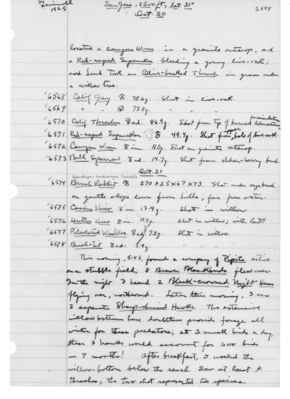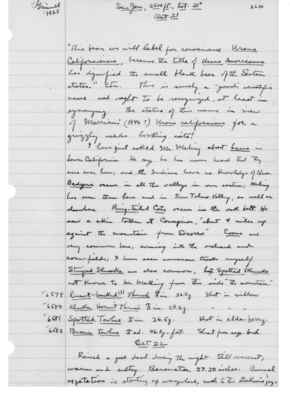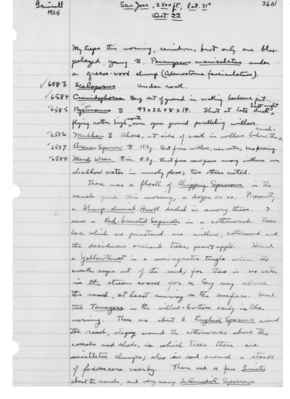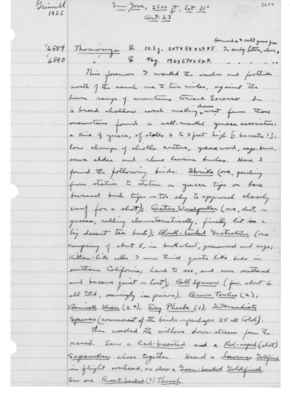Pages
S3 Page 55
Collector: Grinnell - 1925 Location: San Jose, 2500 ft., Lat. 31 degrees Date: October 20, 1925 Page Number: 2598
located a Canyon Wren in a granite outcrop, and a Red-naped Sapsucker bleeding a young live-oak; and Lamb took an Olive-backed Thrush in grass under a willow tree. 6568 Calif. Jay (male sign) 78.6g. Shot in live-oak. 6569 Calif. Jay (female sign) 73.8g. Shot in live-oak. 6570 Calif. Thrasher (female sign) ad. 86.9g. Shot from tip of burned Adenostoma fasciculatum. 6571 Red-naped Sapsucker (male sign) 49.4g. Shot from upper bole of live-oak. 6572 Canyon Wren (male sign) im. 11.0g. Shot on granite outcrop. 6573 Bull Sparrow (male sign) ad. 14.7g. Shot from elder-berry bush. Oct 21. 6574 Brush Rabbit (male sign) 270x25x67x73. Shot under sage brush on gentle slope down from hills, far from water. 6575 Cassin Vireo (male sign) im. 13.9g. Shot in willow. 6576 Hutton Vireo (male sign) im. 11.9g. Shot in willow; with last! 6577 Pileolated Warbler (female sign) ad. 7.2g. Shot in willows. 6578 Bush-tit (male sign) ad. 5.4g. Shot in willow. This morning 5:45, found a company of Pipits active on a stubble field; 8 Brewer Blackbirds flew over. In the night I heard 2 Black-crowned Night Herons flying over, northward. Later this morning, I saw 3 separate Sharp-shinned Hawks. The extensive willow bottoms here doubtless provide forage all winter for the predators; at 3 small birds a day, these 3 hawks would account for 600 birds in 7 months! After breakfast, I worked the willow-bottom below the ranch. Saw at least 4 thrushes; the two shot represented two species.
S3 Page 56
Collector: Grinnell - 1925 Location: San Jose, 2500 ft., Lat. 31 degrees Date: October 21, 1925 Page Number: 2599
a Cassin Vireo taken is the first of the species seen by me this trip. The continued presence of Pileolated Warblers suggests that they may winter here. I saw a company of 12 or so Chipping Sparrows in small willows next to the sage. Heard a single Lawrence Goldfinch. Red-shafted Flickers are impressively common. Saw one Sparrow Hawk. In the book-case at the Meling's I ran across the following book:
| True | Bear Stories | By Joaquin Miller, | with |
|---|---|---|
| Introductory Notes | by | Dr. David Starr Jordan, |
| President of Leland Stanford, Jr., University. | Together | |
| with a thrilling account of the | capture of the | |
| celebrated | grizzly "Monarch" | Fully Illustrated. |
| Chicago and New York; | Rand, McNally and Company, |
| has a separte (sic) title: Scientific | Classification |
|---|
| Black Bear of California. | Ursus Californiensis." |
|---|
S3 Page 57
S3 Page 57
Collector: Grinnell - 1925 Location: San Jose, 2500 ft., lat. 31° Date: Oct. 21 Page Number: 2600
“This bear we will label for convenience Ursus Californiensis, because the title of Ursus Americanus has dignified the small black bear of the Eastern states.” Etc. This is surely a “good” scientific name and ought to be recognized, at least in synonymy. The status of this name in view of Merriam's (1896?) Ursus Californicus for a grizzly needs looking into!
I have just asked Mr. Meling about bears in Lower California. He says he has never heard that they were ever here; and the Indians have no knowledge of them. Badgers occur in all the valleys in one section; Meling has seen them here and in San Telmo Valley, as well as elsewhere. Ring-tailed Cats occur in the oak belt. He saw a skin taken at Concepcion, “about 4 miles up against the mountain from Socorro.” Coons are very common here, coming into the orchard and corn-fields; I have seen numerous tracks myself.
Striped Skunks are also common, but Spotted Skunks not known to Mr. Meling from this side “the mountain.” 6579 Russet-backed Thrush (female sign) im. 26.8g. Shot in willow. 6580 Alaska Hermit Thrush (male sign) im. 24.2g. “ “ “ 6581 Spotted Towhee (male sign) im. 36.5g. Shot in elder-berry. 6582 Brown Towhee (male sign) ad. 46.0g. in fat. Shot from sage-bush.
Oct. 22 Rained a good deal during the night. Still overcast; warm and sultry. Barometer, 27.20 inches. Annual vegetation in starting up everywhere, much to the stockmen’s joy.
S3 Page 58
S3 Page 58
Collector: Grinnell - 1925 Location: San Jose, 2500 ft., lat. 31° Date: Oct. 22 Page Number: 2601
My traps this morning, rained on, brot only one blue pelaged, young (male sign), Peromyscus manipulatus under a grease-wood clump (Adenostoma fasciculatum).
6583 Sceloporus Under rock. 6584 Cnemidophorus Dug out of ground in making barbecue pit. 6585 Nyctinomus (male sign) 93 x 32 x 8 x 14. Shot at late last dusk last night flying rather high north over open ground paralleling willows. 6586 Mudhen (female sign) alone, at side of creek in willow bellow the ranch. 6587 Brewer Sparrow (male sign) 11.9g. Shot from willow, near water; was preening. 6588 Marsh Wren (male sign) im. 11.9g. Shot from sawgrass among willows near shallow water in marshy place; two others noted.
There was a flock of Chipping Sparrows in the ranch yard this morning, a dozen or so. Presently a Sharp-shinned Hawk dashed in among them. I saw a Red-breasted Sapsucker in a cottonwood. Trees here which are punctured one willow, cottonwood and the deciduous orchard trees, pear & apple. Heard a Yellowthroat in a semi-aquatic tangle where the creek seeps out of the sand; for there is no water in the stream course for a long way above the ranch, at least running on the surface. Heard two Tanagers in the willow-bottom early in the morning. There are about 6 English Sparrows around the ranch, staying around the cottonwoods above the corrals and sheds, in which trees there are mistletoe clumps; also in and around a stock of fodder corn nearby. There are a few Linnets about the ranch, and very many Intermediate Sparrows.
S3 Page 59
S3 Page 59
Collector: Grinnell - 1925 Location: San Jose, 2500 ft., lat. 31° Date: Oct. 23 Page Number: 2602
6589 Thomomys (female sign) 123g. 207 x 58 x 29 x 5. In sandy bottom, where bermuda & salt grass grow. 6590 “ (female sign) 96g. 190 x 57 x 25 x 4. “ “ “ “ “ “
This forenoon I worked the washes and foothills north of the ranch one to two miles, against the lower range of mountains toward Socorro. In a broad shallow wash down west from those mountains found a well-marked yucca association: a kind of yucca, of stalks 6 to 8 feet high [= buccata?]; low clumps of cholla cactus, greasewood, sage-brush, some alder and rhus laurina bushes. Here I found the following birds: Shrike (one, perching from station to station in yucca tips on bare burned bush tips - too shy to approach closely enuf for a shot); Cactus Woodpecker(one, shot, on yuccas, calling characteristically, finally lit in a big desert tea bush); Black-tailed Gnatcatcher (one company of about 5, in buckwheat, greasewood and sage; kitten-like calls I now think quite like birds in Southern California; hard to see, and soon scattered and became quiet - lost); Ball Sparrow (few, about 6 all told, seemingly in pairs); Brown Towhee (2); Bewick Wren (2+); Say Phoebe (1); Intermediate Sparrow (commonest of the birds - perhaps all 25 told).
Then worked the willows down-stream from the ranch. Saw a Red-breasted and a Red-naped (shot) Sapsucker close together. Heard a Lawrence Goldfinch in flight overhead, as also a Green-backed Goldfinch. Saw one Russet-backed (?) Thrush.




